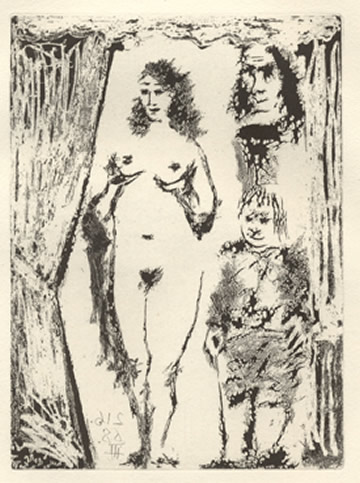 This original
aquatint etching, Untitled,
1971
(Bloch catalog number 1657) is from the
Portfolio of La Célestine which is part of the
347 Series.
This original
aquatint etching, Untitled,
1971
(Bloch catalog number 1657) is from the
Portfolio of La Célestine which is part of the
347 Series.
Between March 16 and October 5, 1968, Picasso created 347 etchings and
aquatints (some days completing 2 or 3 etching plates), an astonishing
outpouring of energy when Picasso was 86 years old. The series
began shortly after the
death of his companion and friend, Catalan poet Jaime Sabartés
(1881-1968). Picasso dedicated
a set of proofs in his memory.
The 66 etching plates for this Portfolio
of La Célestine were
completed between April 11 and August 18, 1968.
With
irony and ribald humor Picasso reviewed his life in the 347 Series,
his failing powers and his place in history. In fact, Picasso is
often observed in much of the 347
Series as voyeur in these
images of fantasy and imagination.
The series was
printed in collaboration with brothers Piero (1934-2001) and Aldo
Crommelynck who, in 1963, set up a studio in Mougins when Picasso was
82 years old. Picasso's prolific production relied on the
absolute trust he had between himself and the master
engravers.
This portfolio was published by Editions de l'Atelier Crommelynck in
Paris in 1971. It was created in a book edition of 350
plus 30 HC (hors commerce)
examples of which this one is numbered XXIII/XXX. Picasso signed
the justification page of the portfolio of 66 prints rather than each
one individually. In addition, as part of the 347 Series 50
impressions were printed on a larger paper (of each of the 66 images).
This etching is untitled because
Picasso usually had no use for titles.
To illustrate La
Célestine, Picasso mainly used the lift-ground process on
greased copper plates.
La Tragicomedia
de Calisto y Melibea, known by the title La
Celestina,
is a dramatized novel in 21 acts, attributed to
Fernando de Rojas, who published it in Burgos in 1499. Because of
its
lively prose dialogue, its well-developed characters, and its striking
description of the mores of Spain at the time of the Catholic kings--
that is during the transition period between the Middle Ages and the
Renaissance--La
Celestina
is one of the major works in
Spanish literature.
The story is
simple: Calisto is passionately in love with Milibea, who
spurns him. His valet, Sempronio, advises him to offer a generous
bribe
to Celestina, who will then be willing to act as matchmaker.
Celestina
is the most remarkable character in the story; her corruption knows no
bounds, and her cupidity leads her to invent a thousand ruses.
Indeed,
she does succeed in approaching Melibea, a chaste and closely
chaperoned girl, and in awaking her love for Calisto.
Soon the
intermediary finds a way to bring the lovers together, but in her
success lies the portent of doom. When Sempronio and a friend
tell Celestina that she should share the bribe money, and she refuses
to cede any part, they kill her; a crime for which they will be
hanged.
Calisto, pursued by those who know of his secret love, falls from a
ladder and dies, and, finally, Melibea throws herself from the tower of
her father's house. Her poor father is left alone bewailing the
death
of his daughter: "Why have you left
me, sad and alone in this vale
of tears?"
What interested Picasso in the story was the lovers' meetings arranged
by Celestina and held in her presence. Picasso had painted a
realistic, even cruel portrait of the well-known personage in
1903 and elements of the story appear in this portfolio. Picasso pictured
Celestine as a small old woman in black, peeping into a couple's
private moments. Picasso believed that his creation contained ironic
and vulgar elements like Shakespearian plays, which look deep into
human nature.
 This original
aquatint etching,
This original
aquatint etching,  This original
aquatint etching, Untitled,
1971
(Bloch catalog number 1657) is from the
Portfolio of La Célestine which is part of the
347 Series.
This original
aquatint etching, Untitled,
1971
(Bloch catalog number 1657) is from the
Portfolio of La Célestine which is part of the
347 Series.